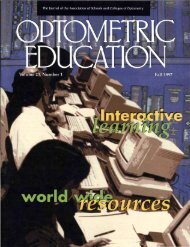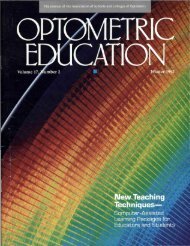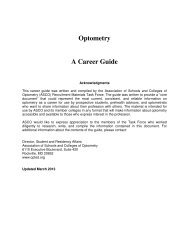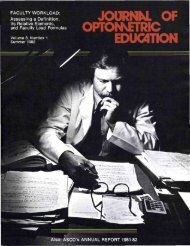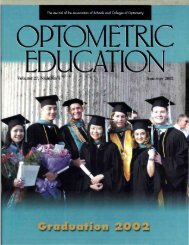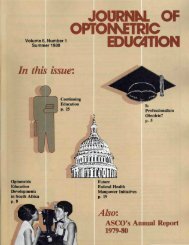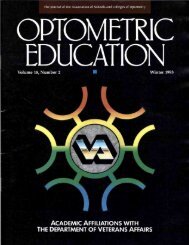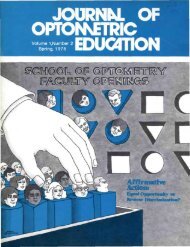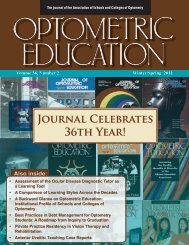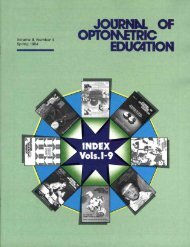Spring 1992, Volume 17, Number 3 - Association of Schools and ...
Spring 1992, Volume 17, Number 3 - Association of Schools and ...
Spring 1992, Volume 17, Number 3 - Association of Schools and ...
You also want an ePaper? Increase the reach of your titles
YUMPU automatically turns print PDFs into web optimized ePapers that Google loves.
Long Range Goals<br />
TABLE 1<br />
Goals <strong>of</strong> a Preceptorship Program<br />
Specific Learning Goals<br />
General Attitude & Value Goals<br />
1. To provide more primary care<br />
optometrists.<br />
2. To encourage students to enter optometric<br />
practice in such underserved<br />
areas as rural <strong>and</strong> inner city<br />
communities.<br />
3. To broaden the scope <strong>of</strong> community<br />
optometric care by developing linkage<br />
between the academic institutions <strong>of</strong><br />
optometry <strong>and</strong> optometric providers in<br />
communities.<br />
1. To provide a clinical learning experience<br />
in primary care as part <strong>of</strong> the<br />
optometry school curriculum.<br />
2. To teach students about the kinds <strong>of</strong><br />
clinical problems encountered in an<br />
<strong>of</strong>fice practice as compared to an academic<br />
clinical setting, including mechanisms<br />
for ensuring comprehensive <strong>and</strong><br />
continuing care.<br />
3. To teach students the diagnostic <strong>and</strong><br />
therapeutic techniques appropriate to<br />
an <strong>of</strong>fice practice.<br />
1. To provide an opportunity for students<br />
to explore <strong>and</strong> evaluate their own<br />
career goals <strong>and</strong> values in optometry.<br />
2. To provide an opportunity for the student<br />
to experience <strong>and</strong> evaluate primary<br />
care as a career path.<br />
3. To allow the student to observe <strong>and</strong><br />
experience the optometric <strong>and</strong> personal<br />
lifestyle <strong>of</strong> a primary care optometrist in<br />
a community.<br />
developed to assess the impact <strong>of</strong> the<br />
experience on the career choices <strong>of</strong><br />
optometric students.<br />
2. Specific learning goal teach students<br />
how to use the available health<br />
resources in an area.<br />
Program characteristic - optometry<br />
students have an opportunity to use<br />
health resources, <strong>and</strong> will be evaluated<br />
on how well they use resources.<br />
3. General Attitude <strong>and</strong> value goals - to<br />
provide an opportunity for students<br />
to explore <strong>and</strong> evaluate career goals<br />
<strong>and</strong> values in optometry.<br />
Program characteristic - optometry<br />
students identify values <strong>and</strong> career<br />
goals both before <strong>and</strong> after the preceptorship.<br />
The change is noted <strong>and</strong><br />
career counseling is made available.<br />
Program Development<br />
Initiation<br />
Preceptorship programs may be<br />
initiated by any one <strong>of</strong> the three<br />
groups typically involved in a preceptorship<br />
experience: optometric faculty<br />
<strong>and</strong>/or administrators, optometric<br />
students <strong>and</strong> community optometrists.<br />
Although a particular group<br />
<strong>of</strong>ten formulates the initial idea,the<br />
cooperation <strong>of</strong> the other two groups<br />
is necessary for success.<br />
This does not mean that an initiator<br />
with only a vague idea should immediately<br />
solicit the collaboration <strong>of</strong><br />
others. To gain needed support, initiators<br />
should familiarize themselves<br />
with some basic issues in program<br />
development. They should have a<br />
clear conception <strong>of</strong> the goals <strong>of</strong> the<br />
proposed learning experience <strong>and</strong><br />
4. To teach students to view <strong>and</strong> treat<br />
patients in the context <strong>of</strong> their lifestyle,<br />
occupation <strong>and</strong> community.<br />
5. To permit students to apply basic<br />
classroom knowledge in the biomedical<br />
<strong>and</strong> behavioral sciences to direct<br />
patient care situations.<br />
6. To broaden <strong>and</strong> enhance the student's<br />
interviewing <strong>and</strong> related skills through<br />
experience in providing care in an <strong>of</strong>fice<br />
setting.<br />
7. To provide knowledge through experience<br />
<strong>of</strong> the referral <strong>and</strong> consultation<br />
processes in a community setting with<br />
multiple <strong>and</strong> varied health resources.<br />
8. To help the student underst<strong>and</strong> the<br />
role <strong>and</strong> lifestyle <strong>of</strong> the primary care<br />
optometrist in the total health care system<br />
<strong>of</strong> a community. ....<br />
9. To enable the student to learn though<br />
experience with the roles <strong>of</strong> <strong>of</strong>fice personnel,<br />
e.g., <strong>of</strong>fice manager, optometric<br />
technicians/assistants <strong>and</strong> dispensers.<br />
10. To develop in the student an underst<strong>and</strong>ing<br />
<strong>of</strong> preventive health practices<br />
<strong>and</strong> their use in a primary care practice.<br />
11. To provide an underst<strong>and</strong>ing <strong>of</strong> public<br />
health <strong>and</strong> environmental factors in<br />
relation to the private practice <strong>of</strong><br />
optometry.<br />
12. To expose the student to the business<br />
<strong>and</strong> monitoring aspects <strong>of</strong> optometric<br />
practice, such as bookkeeping, record<br />
systems, appointment scheduling <strong>and</strong><br />
payment mechanisms.<br />
4. To allow the student to become<br />
acquainted with the methods used by<br />
the primary care optometrist for continuing<br />
education.<br />
5. To encourage the patient to value<br />
such concepts <strong>and</strong> practices as continuity<br />
<strong>of</strong> care, treatment in a family/community<br />
context <strong>and</strong> the optometrypatient<br />
relationship as they affect health<br />
<strong>and</strong> illness.<br />
6. To develop an awareness in the student<br />
<strong>of</strong> roles <strong>and</strong> skills <strong>of</strong> other health<br />
pr<strong>of</strong>essionals.<br />
should be prepared to answer potential<br />
questions from each group whose<br />
collaboration is sought. For example,<br />
optometric faculty might be concerned<br />
with: monitoring the educational<br />
quality <strong>of</strong> the experience; the<br />
qualifications <strong>of</strong> the proposed preceptors;<br />
whether the curriculum already<br />
includes similar learning goals; the<br />
effort <strong>and</strong> time required by faculty;<br />
<strong>and</strong> the method <strong>of</strong> evaluation <strong>of</strong><br />
students.<br />
Optometry school administrators<br />
will be concerned with the same<br />
issues 9 , as well as with factors such<br />
as liability <strong>and</strong> administration costs<br />
<strong>and</strong> procedures.<br />
Optometry students will be concerned<br />
with: the program's place in<br />
the overall curriculum; the program's<br />
educational value relative to other<br />
curricular opportunities; whether the<br />
program will be required or elective;<br />
the extent to which they will have<br />
freedom to choose the site <strong>and</strong> the<br />
preceptor; methods for evaluating<br />
their performance; <strong>and</strong> financial aid.<br />
<strong>Volume</strong> <strong>17</strong>, <strong>Number</strong> 3 / <strong>Spring</strong> <strong>1992</strong> 91



